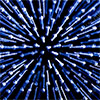[ad_1]
(Nanowerk news) The research neutron source Hein Maier-Leibnitz (FRM II) at the Technical University of Munich (TUM) plays an important role in the investigation of mRNA nanoparticles similar to those used in the Covid-19 vaccines from the manufacturers BioNTech and Moderna . Researchers at the Heinz Maier-Leibnitz Center (MLZ) used the high neutron flux available in Garching to characterize various formulations for the mRNA vaccine and thus lay the foundation for improved vaccine effectiveness.
The idea of ​​using messenger RNA (mRNA) as an active ingredient is ingenious: the molecule contains the specific blueprint for proteins, which are then synthesized by the cell. This generally makes it possible to provide a very broad spectrum of different therapeutically effective proteins.
In the case of the Covid-19 vaccine, these are the proteins of the characteristic spikes on the surface of the corona virus that are used for vaccination. The proteins are presented on the surface of immune cells; then the human immune system triggers defense against these foreign proteins and thus against the corona virus. The mRNA itself is completely broken down after a few hours, which is an advantage for the safety of these vaccines.
The way to the best packaging
The mRNA has to be packaged appropriately so that it is not broken down by the ubiquitous enzymes in the human body on its way into the cell. This is done with nanoparticles, which can consist of a mixture of lipids or polymers.
The lipids are fat molecules similar to the molecules of the cell membrane and help to store the mRNA inside the cell. Lipids and biopolymers are then broken down or excreted by the body.
The BioNTech formulation team led by Dr. Heinrich Haas and Prof. Peter Langguth’s group from the Chair of Pharmaceutical Technology at the Institute for Pharmaceutical and Biomedical Sciences at Johannes Gutenberg University Mainz. They developed a series of formulations in which the nanoparticles consisted of various mixtures of lipids and biopolymers that have already been tried and tested in pharmacy.
In the light of neutrons
In order to compare the properties of differently composed nanoparticles with one another, the researchers subjected the nanoparticles to different investigations. In addition to X-ray and microscope analyzes, these investigations also included irradiation with neutrons with the KWS-2 instrument, which is operated by the Jülich Research Center at the FRM II of the Technical University of Munich in Garching.
The neutrons are scattered inside the nanoparticles on the hydrogen nuclei, among other things, and are deflected from their orbits in a characteristic way. This is the basis for inferences about their distribution. If the hydrogen atoms of certain components – for example only the lipids – are exchanged for heavy hydrogen, the chemical properties and the pharmaceutical effectiveness do not change, but the scattering pattern of the neutrons does.
“This method makes it possible to highlight parts of a complex multi-component morphology without changing the physical chemistry of the sample,” says Dr. Aurel Radulescu from the Jülich Center for Neutron Science (JCNS), responsible for the KWS -2 instrument and who led the evaluation of the measurement results. “This allows structural properties to be mapped that can hardly or not at all be made visible with other methods.”
The right degree of order is the key
During these analyzes, the research teams were interested in how efficiently the various formulations can transfer the mRNA into the cell, known as transfection. The researchers found that the highest transfection rates are achieved with nanoparticles that are characterized by a certain type of internal arrangement.
“High biological activity was always registered when ordered and less ordered areas inside the nanoparticles alternated in a characteristic way. This could be a general concept of the structure-activity relationship that can be applied independently of the systems examined here. ” Heinrich Haas from BioNTech points this out. The research teams had previously found a similarly low degree of order in other lipid nanoparticles using X-rays.
An improved process
In order to obtain the desired structural properties, lipids and biopolymers had to be combined with the mRNA according to precisely defined processes. Here the research team was able to show that the nanoparticles for packaging the mRNA can be produced in one step, which means a significant simplification compared to the two-step process that was originally also examined.
Finally, a simplified method for the production of mRNA nanoparticles with improved activity was found. “Such questions of practical manufacturability represent an important prerequisite for the possibility of developing pharmaceutical products,” says Prof. Langguth. In the future, such concepts could be taken into account in the development of new mRNA-based therapeutics.
Publications:
Hybrid biopolymer and lipid nanoparticles with improved transfection efficiency for mRNA. Christian D. Siewert, Heinrich Haas, Vera Cornet, Sara S. Nogueira, Thomas Nawroth, Lukas Uebbing, Antje Ziller, Jozef Al-Gousous, Aurel Radulescu, Martin A. Schroer, Clement E. Blanchet, Dmitri I. Svergun, Markus P Radsak, Ugur Sahin and Peter Langguth. Cells 2020, 9 (9), 2034 – DOI: 10.3390 / cells9092034
Investigation of the variation in charge ratio in mRNA-DEAE-Dextran-Polyplex delivery systems. C. Siewert, H. Haas, T. Nawroth, A. Ziller, SS Nogueira, MA Schroer, CE Blanchet, DI Sverg, A. Radulescu, F. Bates, Y. Huesemann, MP Radsak, U. Sahin, P. Langguth . Biomaterials, 2019; DOI: 10.1016 / j.biomaterials.2018.10.020
Polysarcosine-functionalized lipid nanoparticles for therapeutic mRNA delivery. SS Nogueira, A. Schlegel, K. Maxeiner, B. Weber, M. Barz, MA Schroer, CE Blanchet, DI Svergun, S. Ramishetti, D. Peer, P. Langguth, U. Sahin, H. Haas. ACS appl. Nanomatter. 2020, 3, 11, 10634-10645 – DOI: 10.1021 / acsanm.0c01834
[ad_2]

